Philippines Munchies: Filipino Street Foods Satisfactions!
Welcome to Manila, a vibrant city boasting a deep history, engaging culture, and a variety of Filipino Street Foods that will tantalize your taste buds. The city is perfect for any food enthusiast desiring to discover the myriad of taste sensations the Philippine streets offer. Ready to savor the uniquely appetizing treat that is Filipino street food? Dive straight into these top 10 irresistible Filipino street food delights.
1. Balut

Balut is a Filipino delicacy that has gained both fame and notoriety globally. It is a fertilized duck egg with a nearly developed embryo inside that is boiled and eaten in the shell. The origins of Balut are a bit murky, but it is believed to have been influenced by Chinese traders who visited the Philippines centuries ago. It is commonly sold as street food in the Philippines and has become a rite of passage for many Filipino youths and a symbol of Filipino culinary daring for tourists. Balut is usually eaten with a pinch of salt or a splash of vinegar to enhance its flavor.
Trivia
- Balut eggs are typically incubated for 14 to 21 days before being boiled, with the 17-day-old embryos being most preferred because they strike a balance between the developed features and tenderness.
- It’s considered to be a natural aphrodisiac and is also believed to be high in protein.
- The Philippine city of Pateros is famously known for its Balut and even celebrates an annual “Balut sa Puti” festival, which pays homage to this unique food item.
2. Isaw
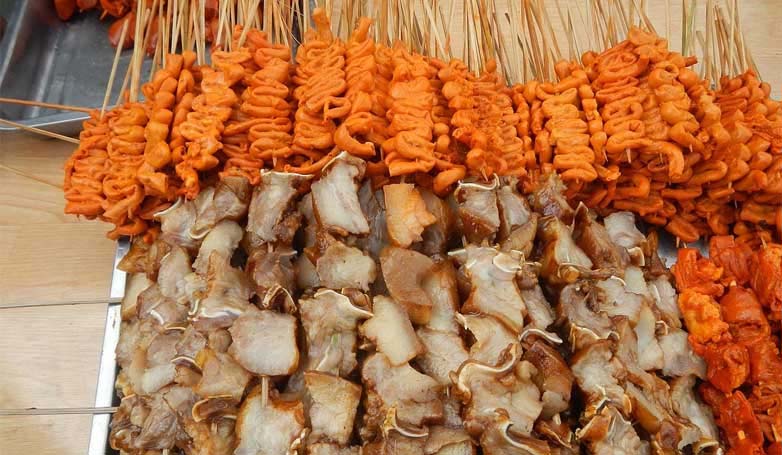
Isaw is one of the common Filipino street foods from the Philippines made from barbecued pig or chicken intestines. The intestines are cleaned, turned inside out, washed thoroughly, then skewered and grilled. Isaw has been part of Filipino street food culture for many years, reflecting the Filipino trait of resourcefulness by utilizing parts of the animal that might otherwise be discarded. Like many Filipino foods, isaw was born out of the need to maximize resources, and it has become a favorite among locals for its distinctive taste and texture when grilled and dipped in spicy vinegar.
Trivia
- Isaw vendors often boast their special vinegar-based dips, which can range from sweet and spicy to tangy, and are considered an integral part of the isaw experience.
- Health-conscious individuals may shy away from isaw because of its high cholesterol content; however, it remains a popular snack, especially during outdoor drinking sessions called “inuman.”
- The name “isaw” is derived from its appearance, as the coiled intestines resemble the Filipino word “saw” which means “to saw” or “saw blade.”
3. Fish Balls

Fish balls are one of the common snacks and Filipino street foods in the Philippines. They are made from fish paste, which is then shaped into balls and deep-fried until golden brown. Street vendors typically serve them skewered on bamboo sticks, accompanied by a choice of dipping sauces such as sweet, sour, or spicy. The practice of making fish balls was likely brought to the Philippines by Chinese immigrants and adapted using local ingredients. It provides a quick and affordable source of protein, which made it particularly popular among the working class.
Trivia
- Fish balls are usually made from the flesh of cuttlefish or pollock, providing a springy texture that’s beloved by consumers.
- They are a ubiquitous sight in Philippine schools, with vendors often setting up nearby to cater to children and students.
- The largest fish ball in the Philippines was created in the City of Dagupan on April 30, 2014, measuring four feet in diameter and made from “bangus,” also known as milkfish.
4. Kwek-Kwek
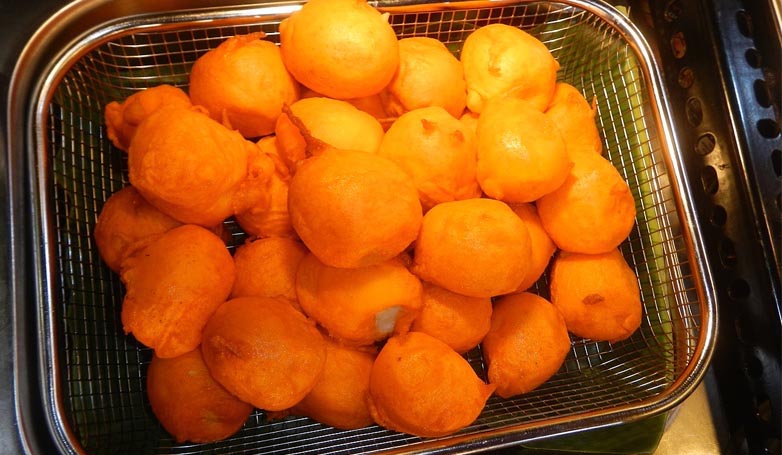
Kwek-kwek is a deep-fried street food in the Philippines consisting of hard-boiled quail eggs coated in an orange batter made of flour, cornstarch, and annatto powder for coloring. It is a variation of “tukneneng,” which uses chicken eggs. The snack began as an innovative way to sell quail eggs, which were less popular than chicken eggs, by making them visually appealing and convenient to eat on the go. Kwek-Kwek is typically served with a vinegar-based dip or a sweet and spicy sauce that complements its savory flavor.
Trivia
- The “kwek-kwek” name is onomatopoetic, resembling the sound of a quail.
- Often found at the same street food stalls that sell balut and isaw, kwek-kwek contributes to the Philippines’ vibrant street food scene.
- Kwek-kwek’s distinct orange color not only makes it attractive but also helps differentiate it from other battered and fried snacks sold in the streets.
5. Halo-Halo

Halo-halo, which translates to “mix-mix” in Tagalog, is a popular Filipino dessert that has its roots in the Japanese kakigōri, a shaved ice dessert. The Filipino adaptation likely began during the American occupation in the early 20th century when ice became widely available in the Philippines. It is a medley of various ingredients, including sweet beans, fruits, tapioca, and nata de coco, topped with shaved ice, evaporated milk, and sometimes ice cream or leche flan. Halo-halo embodies the Filipino penchant for sweet treats and embodies the cultural melting pot that is the Philippines.
Trivia
- Each halo-halo mix can be unique, with some family recipes passed down through generations, reflecting the regional diversity of the Filipino palate.
- “Halo-Halo” was featured in an episode of the TV show “Anthony Bourdain: Parts Unknown” where Bourdain praised it for its complexity and refreshing qualities.
- In 2014, halo-halo was spotlighted in the international culinary scene when it was served as a dessert at the White House State Dinner in honor of Philippine President Benigno Aquino III.
6. Lechon Manok
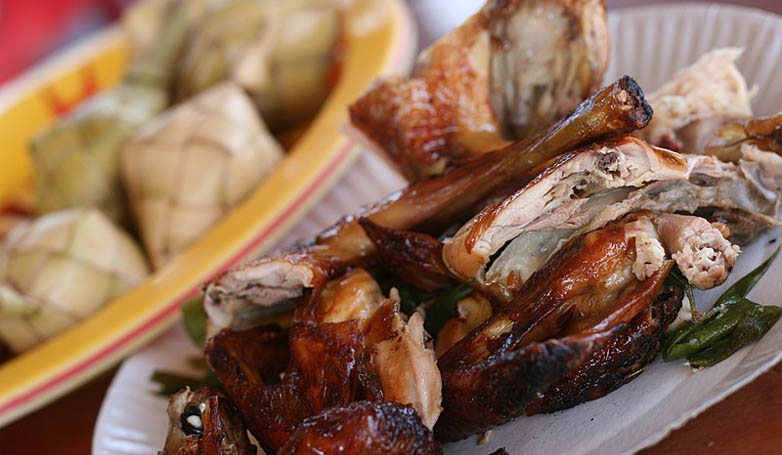
Lechon Manok is the Philippine iteration of spit-roasted chicken, with “Lechon” originally referring to spit-roasted pig and “Manok” meaning chicken. This dish became a culinary sensation in the Philippines in the 1980s, with the emergence of roadside stalls and eateries specializing in the delicacy. The chickens are typically marinated in a blend of flavors including calamansi, garlic, lemongrass, and soy sauce, then roasted over a charcoal flame, resulting in succulent meat with a crispy golden skin. Its popularity soars due to its affordability, accessibility, and the convenience of take-out to complement Filipino feasts and everyday meals.
Trivia
- The term “Lechon” is derived from the Spanish word ‘leche,’ which means milk, originally referring to a roasted suckling pig.
- In 2009, the world’s largest lechon was recorded in the Philippines, stretching over 3,803.96 meters and setting a Guinness World Record.
- Lechon Manok saw a boom in the 1980s because of the energy crisis in the Philippines, which made the traditional Lechon Baboy (roast pig) less affordable.
7. Taho

Taho is a beloved Filipino delicacy made from fresh soft/silken tofu, arnibal (a sweet syrup usually made from caramelized sugar and vanilla), and sago pearls (similar to tapioca pearls). This humble street food has Chinese origins and is thought to have been introduced by Chinese immigrants to the Philippines. Customarily enjoyed as a breakfast treat or midday snack, taho vendors, known as “magtataho,” can be seen walking through neighborhoods carrying two large aluminum buckets on a yoke, calling out to sell their freshly prepared taho.
Trivia
- Magtataho typically begin their day in the early morning hours to serve taho to customers for breakfast.
- There are variations of taho across Southeast Asia with similar names; in Indonesia, it’s known as “Tahwa” and “Douhua” in China.
- Some contemporary versions of taho include flavored syrups like strawberry and ube, catering to a wider range of taste preferences.
8. Puto Bumbong
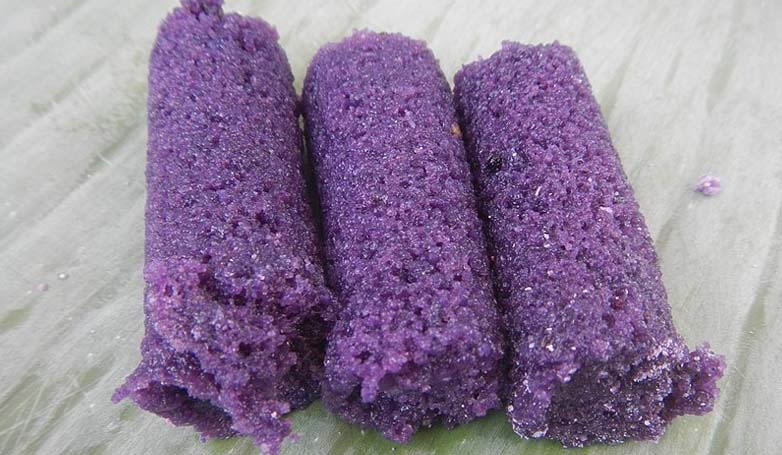
Puto Bumbong is a traditional Filipino delicacy often associated with the Christmas season. The name comes from “puto” (steamed rice cake) and “bumbong” (bamboo tube), which describes its unique cooking process. The dish is made from a special variety of sticky rice called “pirurutong,” which is soaked in water, and ground, and then poured into bamboo tubes before being steamed until they turn a vibrant purple hue. Once cooked, they are spread with butter (or margarine), sprinkled with sugar and shredded coconut. It’s commonly served outside churches during the nine-day Misa de Gallo, leading up to Christmas Day.
Trivia
- Puto Bumbong is uniquely steamed in bamboo tubes, which are traditionally lined with banana leaves for added aroma.
- The purple color of puto bumbong comes from the natural pigment of pirurutong rice, which is a type of glutinous rice.
- With the modern scarcity of the traditional kakanin or rice cake instruments, innovations have included using metal steamers to cook puto bumbong.
9. Betamax
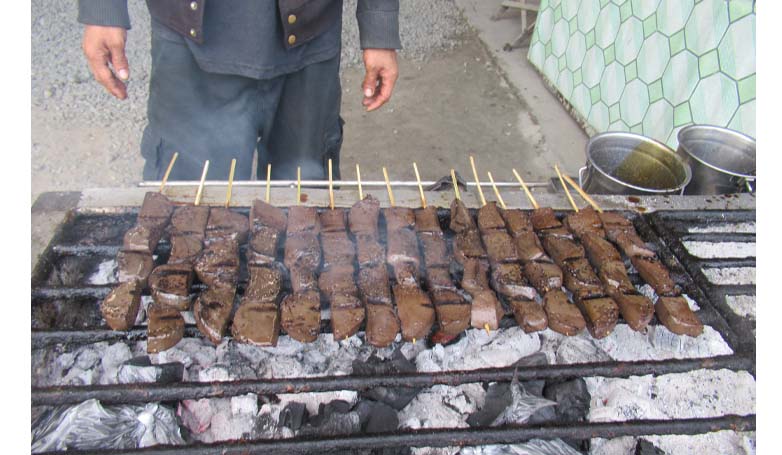
Contrary to what the name suggests, “Betamax” is not a reference to an outdated video cassette format but rather a colloquial name given to a Filipino street food item. It consists of cubed pieces of pork blood that are seasoned, skewered, and then grilled over charcoal. The name stems from the skewered blocks’ resemblance to Betamax tapes. Popularly consumed as a snack or appetizer, especially with beer, Betamax is part of the Filipino tradition of indulging in a variety of grilled organ meats and street foods (collectively known as “isaw”).
Trivia
- Betamax is considered a resourceful way of utilizing animal blood, a byproduct of the butchering process, turning it into a savory snack.
- Despite its unusual ingredient, Betamax is rich in iron and is often enjoyed for its distinctively chewy texture and smoky flavor.
- The playful naming of such street foods as Betamax demonstrates the fun and creativity Filipinos often impart into their cuisine.
10. Bibingka
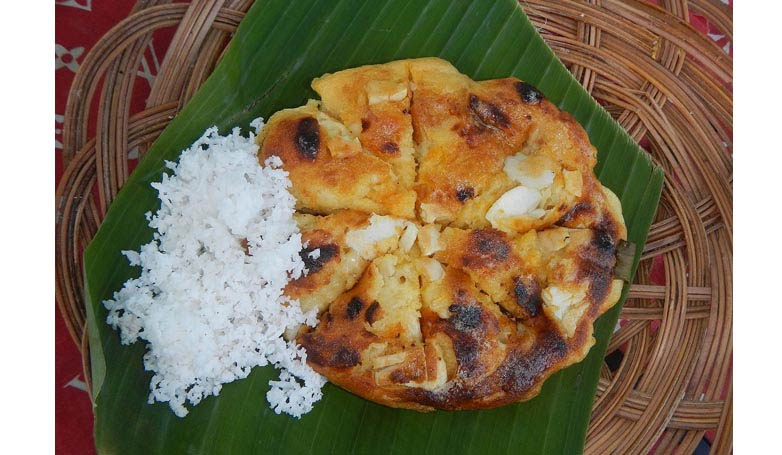
Bibingka is a type of rice cake from the Philippines that’s traditionally made from galapong (milled glutinous rice), coconut milk, sugar, and eggs. This cherished treat is synonymous with the Christmas season in the Philippines, typically eaten during the post-midnight mass celebrations known as Simbang Gabi. Bibingka is baked in a clay pot lined with a banana leaf, giving it a distinctive flavor and aroma. The cake is cooked by placing live coals on top and underneath the clay pot, resulting in a warm, soft interior and a slightly charred surface.
Trivia
- Bibingka stalls frequently pop up outside churches during the Ber months (September through December), as it’s a go-to festive food during this time.
- A well-prepared bibingka might be garnished with salted duck eggs, cheese, and sometimes slabs of butter while still hot from the oven.
- Modern variations of bibingka include toppings and fillings like chorizo, pineapple, and even chocolate, showing how this traditional treat has evolved with contemporary tastes.
Dig into Deliciousness: Signing Off from Philippines Streets!
And there you have it! A culinary journey into the Philippine streets with the top 10 mouth-watering and quintessential Filipino street foods. Whether spicy, sweet, hot, or cold, Manila’s street food scene offers a flavor for everyone. So next time you find yourself navigating Manila’s bustling streets, don’t miss out on these gastronomic treasures that are sure to excite your taste buds and give you an authentic taste of Filipino culture. Happy eating!
Filipino Street Foods in the Philippines FAQs
Here are the most common questions about Filipino street food in the Philippines.
1. Is Filipino Street food expensive?
No, Filipino street food is typically budget-friendly and cheap, which makes it popular among locals and tourists.
2. Are there any vegetarian Filipino street foods?
Yes, there are vegetarian options such as Taho, Sweet Corn, Ginataang Bilo-Bilo, and Buko Salad.
3. Where can I find street food in Manila?
Street food is available almost everywhere in Manila. Some of the best places to experience street food are in Chinatown (Binondo), Banchetto in Ortigas, and Mercato in Bonifacio Global City.
4. What essential tips should I know about street food in Manila?
Always look for busy stalls, as the food will likely be fresher. Don’t be afraid to ask the vendor about how the food is prepared if you’re unsure. Finally, remember to always wash your hands before eating!












